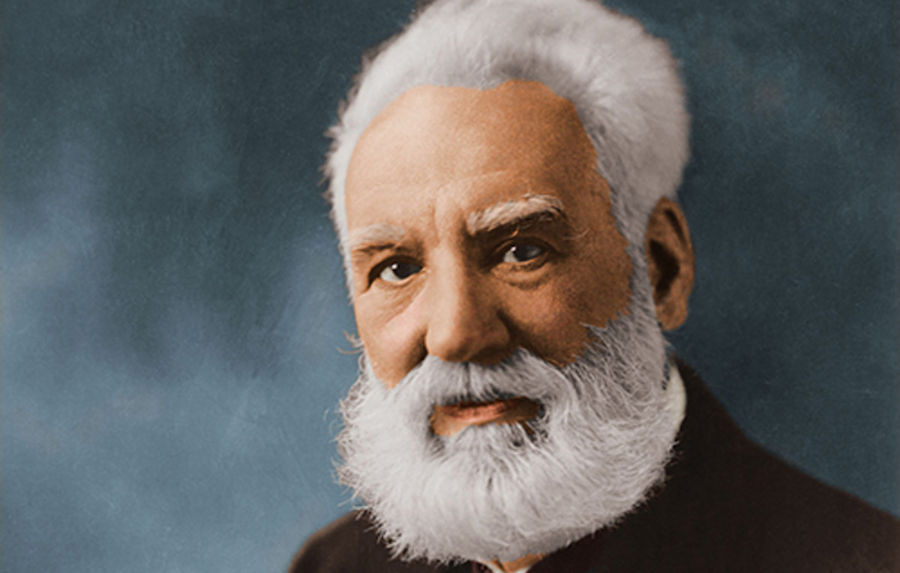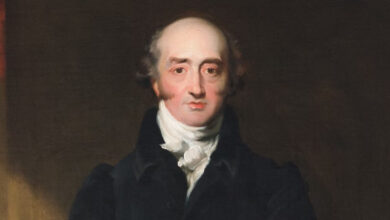
Podcast: Play in new window | Download
Subscribe: Spotify | Amazon Music | Youtube Music | RSS
“Sometimes we stare so long at a door that is closing that we see too late the one that is open.” – Alexander Graham Bell
Alexander Graham Bell was born in the family home on South Charlotte Street in Edinburgh, Scotland on 3 March 1847. He was the middle one of three brothers. His older brother Melville was born in 1845 and his younger brother Edward in 1867. At the time of his birth, Alexander did not have a middle name, but he pleaded with his father to give him one. On his 11th birthday, his father, who was also called Alexander, said ok, and the name Graham was chosen as a way of honouring a family friend.
After being educated initially by his father, Alexander attended the Royal High School in Edinburgh, although he was not an outstanding student. He was often absent from classes and only managed to achieve average grades. When he left school at the age of 15, he travelled to London to live with his grandfather, who was also called Alexander and with whom he spent a lot of time discussing a whole host of different matters and it is thought that it is with his grandfather’s guidance that Alexander started to take study seriously. He also taught him to speak correctly, clearly and with conviction.
When he turned 16, Bell took up a pupil-teacher position at Weston House Academy where he studied Latin and Greek and in return, he took classes in elocution and music, for which he was also paid £10 per session. The following year Alexander joined his brother Melville at the University of Edinburgh before being accepted for a place at the University College London.
Encouraged by their father, Alexander and Melville became fascinated with the sound of human speech and worked together to produce their version of an automaton head, that could speak a few words, and which could be changed slightly by changing the shape of the lips. Intrigued by what they had accomplished, Alexander took the experiment one stage further using the family dog, which he taught to growl whilst Alexander changed the shape of its lips whilst also manipulating its vocal cords, so much so that he could make the dog appear to speak. Similar work had already been conducted in Germany, but by studying the resulting book written by Hermann von Helmholtz, Alexander deduced that he should be able to simulate human speech using electricity.
However, the family would be plunged into crisis when over the course of a few short years between 1867 and 1870, both of Alexander’s brothers died due to complications associated with tuberculosis. Alexander had also been ill, but fortunately had started to recover, resulting in the family deciding that they should move to Canada to give Alexander the best possible chance of a full recovery. So, when he was 23 years old, in 1870 Alexander travelled with his family to Paris, Ontario where they stayed with a Baptist minister and friend of the family, Thomas Henderson, before purchasing a 10.5-acre farm near the town of Brantford. The improved climate allowed Bell to recover much more rapidly and the space on the farm also allowed him to set up a workshop in an old, converted carriage house that he called his dreaming place and where he continued his experiments based on the work of Helmholtz.
Before leaving for Canada, Bell had perfected methods taught by his father to read symbols that represented the sound a word makes, which he and his father called visible speech. Whilst helping his father demonstrate this, he came to the attention of Susanna E. Hull’s private school for the deaf in South Kensington, London where two deaf-mute girls made remarkable progress under his tutelage. After the move to Canada, he continued working with the deaf and was invited by Sarah Fuller, the principal of the Boston School for Deaf Mutes (now called the Horace Mann School for the Deaf), to introduce the idea of visible speech. The programme was so successful that it led to him also teaching the method in Hartford Connecticut and Northampton, Massachusetts.
He had not given up on his idea of simulating human speech using electricity though, and by 1874, Alexander Graham Bell’s work had led to the harmonic telegraph, which was a way of transmitting musical notes and human speech over distance using electricity. He knew that the work could lead to something revolutionary and so to concentrate on his experiments, he gave up most of his lucrative work with patients. He retained only two pupils, a six-year-old boy and a 15-year-old girl called Mabel, whose father was so keen for her to work with Bell that he became Bell’s friend and benefactor. As Alexander and Mabel got to know each other, their relationship blossomed, and although there was a ten-year age gap between the pair, they fell in love and were married on 11 July 1877. They went on to have four children together, two girls Elsie and Marian and two boys who unfortunately died in infancy.
The use of the telegraph system, which had been developed in the 1830s had increased massively over the years and there was a clear need to try and figure out a way of transmitting multiple messages over a single wire to reduce the need to erect new lines and so Bell began researching methods of doing so.
Competition was fierce. Western Union hired Thomas Edison who came up with the quadruplex which could send four messages over a wire simultaneously and other inventors looked for ways of increasing this number, including Bell and his rival Elisha Gray, both of whom developed ways of dividing a line into ten channels and more.
Once the method was established, it wasn’t a massive leap to the idea of transmitting the human voice over these channels and Bell filed a patent describing how this could be done on 14 February 1876 beating Elisha Gray to the punch by only a few hours.
Bell produced the first intelligible speech sent over a wire on 10 March 1876, when he sent a message to his lab assistant, Thomas A. Watson. The words transcribed in Bell’s notes were “Mr. Watson – come here – I want to see you.”
After more work refining the equipment, Bell demonstrated his invention, the telephone, to judges at the Philadelphia Centennial Exhibition and by July 1877, the Bell Telephone Company had been founded with the aim of commercialising the telephone. By the early 1880s, Alexander Graham Bell was an independently wealthy man, but he quickly lost interest in telephony and sold most of his shares.
Some of the money he had accumulated, including that which was awarded as prize money by the French government when he was awarded the Volta Prize for achievement in electrical science was used by Bell to set up the Volta Laboratory which was devoted to studies on deafness. Bell also took an interest in improving Thomas Edison’s phonograph invention. His improvements led to a device called the Graphophone which used removable cardboard cylinders coated in wax to record and play back sound, and which received patent grants in 1886.
The same year, the Bell family moved to a 50-acre plot of land on Cape Breton Island in Nova Scotia, Canada and in 1888 Bell co-founded the National Geographic Society. By the 1890’s he had completely shifted his focus, concentrating on heavier-than-air flight, experimenting with different wing and propellor blade shapes. His work, which continued even after the Wright Brothers succeeded with their attempts at heavier-than-air flight contributed significantly to the career of aviation pioneer Glenn A. Curtiss. Alexander Graham Bell died on 2 August 1922 at his Cape Breton home at the age of 75 due to complications arising from diabetes. He was buried at the top of Beinn Bhreagh mountain on the estate overlooking Bras d’Or Lake.
Podcast: Play in new window | Download
Subscribe: Spotify | Amazon Music | Youtube Music | RSS




